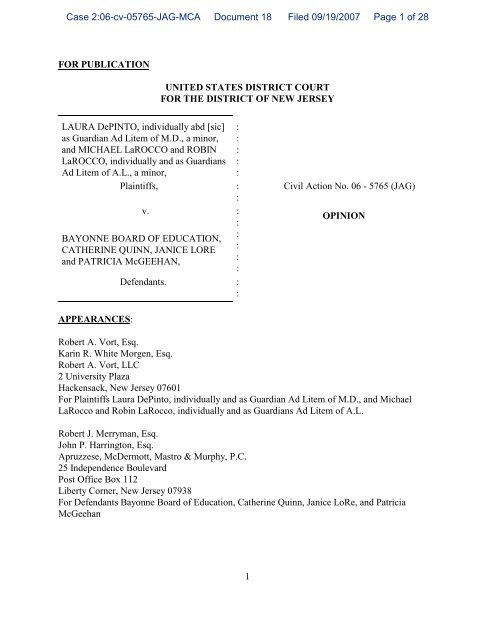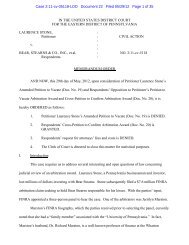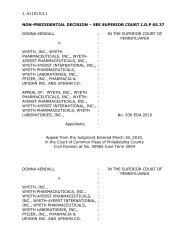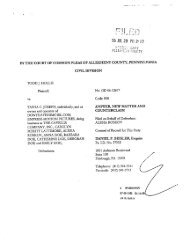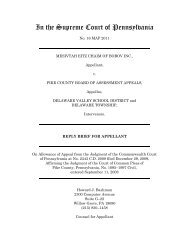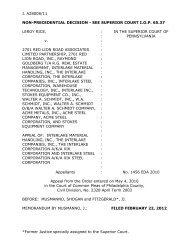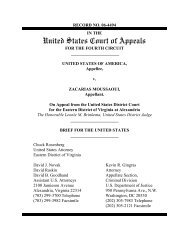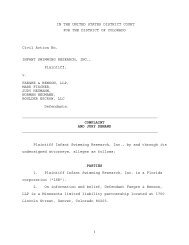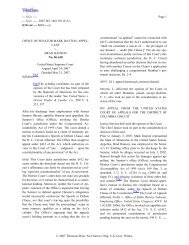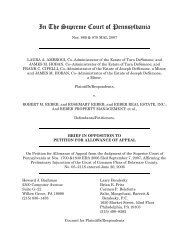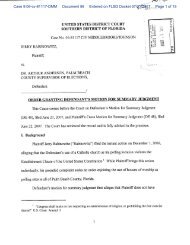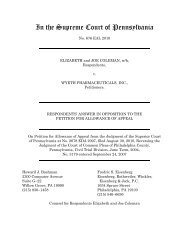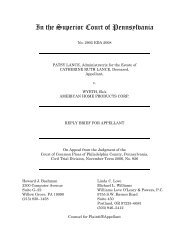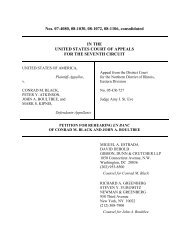DePinto v. Bayonne Board of Education
DePinto v. Bayonne Board of Education
DePinto v. Bayonne Board of Education
Create successful ePaper yourself
Turn your PDF publications into a flip-book with our unique Google optimized e-Paper software.
Case 2:06-cv-05765-JAG-MCA Document 18 Filed 09/19/2007 Page 1 <strong>of</strong> 28<br />
FOR PUBLICATION<br />
LAURA DePINTO, individually abd [sic]<br />
as Guardian Ad Litem <strong>of</strong> M.D., a minor,<br />
and MICHAEL LaROCCO and ROBIN<br />
LaROCCO, individually and as Guardians<br />
Ad Litem <strong>of</strong> A.L., a minor,<br />
Plaintiffs, :<br />
:<br />
v.<br />
:<br />
:<br />
BAYONNE BOARD OF EDUCATION,<br />
:<br />
CATHERINE QUINN, JANICE LORE<br />
:<br />
and PATRICIA McGEEHAN,<br />
:<br />
:<br />
Defendants. :<br />
:<br />
APPEARANCES:<br />
UNITED STATES DISTRICT COURT<br />
FOR THE DISTRICT OF NEW JERSEY<br />
:<br />
:<br />
:<br />
:<br />
:<br />
1<br />
Civil Action No. 06 - 5765 (JAG)<br />
OPINION<br />
Robert A. Vort, Esq.<br />
Karin R. White Morgen, Esq.<br />
Robert A. Vort, LLC<br />
2 University Plaza<br />
Hackensack, New Jersey 07601<br />
For Plaintiffs Laura <strong>DePinto</strong>, individually and as Guardian Ad Litem <strong>of</strong> M.D., and Michael<br />
LaRocco and Robin LaRocco, individually and as Guardians Ad Litem <strong>of</strong> A.L.<br />
Robert J. Merryman, Esq.<br />
John P. Harrington, Esq.<br />
Apruzzese, McDermott, Mastro & Murphy, P.C.<br />
25 Independence Boulevard<br />
Post Office Box 112<br />
Liberty Corner, New Jersey 07938<br />
For Defendants <strong>Bayonne</strong> <strong>Board</strong> <strong>of</strong> <strong>Education</strong>, Catherine Quinn, Janice LoRe, and Patricia<br />
McGeehan
Case 2:06-cv-05765-JAG-MCA Document 18 Filed 09/19/2007 Page 2 <strong>of</strong> 28<br />
GREENAWAY, JR., U.S.D.J.<br />
This matter comes before the Court on the motion for a preliminary injunction by<br />
Plaintiffs Laura <strong>DePinto</strong> (“<strong>DePinto</strong>”), individually and as guardian ad litem <strong>of</strong> M.D., a minor,<br />
and Michael and Robin LaRocco (the “LaRoccos”), individually and as guardians ad litem <strong>of</strong><br />
A.L., a minor (collectively “Plaintiffs”), seeking to enjoin Defendants <strong>Bayonne</strong> <strong>Board</strong> <strong>of</strong><br />
<strong>Education</strong> (“<strong>Bayonne</strong> BOE”), Catherine Quinn (“Quinn”), Janice LoRe (“LoRe”) and Patricia<br />
McGeehan (“McGeehan”) from imposing sanctions on M.D. and A.L. for wearing a button to<br />
school, featuring a photograph <strong>of</strong> members <strong>of</strong> the Hitler Youth. For the reasons set forth below,<br />
the motion for a preliminary injunction is granted.<br />
INTRODUCTION<br />
This case is about buttons. Two fifth grade students attending two separate elementary<br />
schools in the <strong>Bayonne</strong> School District (the “District”) wore a button to protest the District’s<br />
mandatory uniform policy (the “Button”). The Button bears the phrase “No School Uniforms”<br />
and a slashed red circle. The writing overlays a historical photograph that appears to portray the<br />
Hitler Youth. The picture depicts dozens <strong>of</strong> young boys dressed in the same uniforms and all<br />
facing the same direction. There are no visible swastikas or any other definitive indication that<br />
the boys are members <strong>of</strong> the Hitler Youth; however, the parties do not appear to contest that the<br />
picture portrays an assemblage <strong>of</strong> the Hitler Youth.<br />
Following the days on which M.D. and A.L. wore the Button, the District sent identical<br />
letters home to each student’s parents. The letters stated that “[t]he background images on this<br />
badge are considered objectionable[,] are <strong>of</strong>fensive to many <strong>Bayonne</strong> citizens[,] and do not<br />
constitute free speech according to Mr. Kenneth Hampton, attorney for the <strong>Bayonne</strong> <strong>Board</strong> <strong>of</strong><br />
2
Case 2:06-cv-05765-JAG-MCA Document 18 Filed 09/19/2007 Page 3 <strong>of</strong> 28<br />
<strong>Education</strong>.” (Verified Complaint Exs. B and C.) The letters threatened suspension in the event<br />
that M.D. and A.L. wore the buttons again. The parents <strong>of</strong> M.D. and A.L. filed this suit alleging<br />
violation <strong>of</strong> the First Amendment right <strong>of</strong> free speech.<br />
I. Governing Legal Standards<br />
DISCUSSION<br />
A. Standard for Preliminary Injunction<br />
The grant <strong>of</strong> injunctive relief is an “extraordinary remedy, which should be granted only<br />
in limited circumstances.” Instant Air Freight Co. v. C. F. Air Freight, Inc., 882 F.2d 797, 800<br />
(3d Cir. 1989) (quoting Frank’s GMC Truck Center, Inc. v. General Motors Corp., 847 F.2d 100,<br />
102 (3d Cir. 1988)). Generally, in determining whether to grant a preliminary injunction or a<br />
temporary restraining order, courts in this Circuit review four factors:<br />
(1) whether the movant has a reasonable probability <strong>of</strong> success on the merits; (2)<br />
whether the movant will be irreparably harmed by denying the injunction; (3)<br />
whether there will be greater harm to the nonmoving party if the injunction is<br />
granted; and (4) whether granting the injunction is in the public interest.<br />
Sypniewski v. Warren Hills Reg’l Bd. <strong>of</strong> Educ., 307 F.3d 243, 252 (3d Cir. 2002) (citing<br />
Highmark, Inc. v. UPMC Health Plan, Inc., 276 F.3d 160, 171 (3d Cir. 2001)); see also<br />
Continental Group, Inc. v. Amoco Chem. Corp., 614 F.2d 351, 356-57 (3d Cir. 1980) (the four<br />
factors listed above are known as the Continental factors).<br />
The applicant must meet its burden on the first two factors before the Court will consider<br />
the third and fourth factors. See Reebok Int’l Ltd. v. J. Baker, Inc., 32 F.3d 1552, 1555-56 (Fed.<br />
Cir. 1994) (“Because, irrespective <strong>of</strong> relative or public harms, a movant must establish both a<br />
likelihood <strong>of</strong> success on the merits and irreparable harm . . ., the district court may deny a<br />
3
Case 2:06-cv-05765-JAG-MCA Document 18 Filed 09/19/2007 Page 4 <strong>of</strong> 28<br />
preliminary injunction based on the movant’s failure to establish either <strong>of</strong> these two crucial<br />
factors without making additional findings respecting the other factors.”). “[C]onsideration <strong>of</strong><br />
these factors by the district court requires a ‘delicate balancing.’” Delaware River Port Auth. v.<br />
Transamerican Trailer Transp., Inc., 501 F.2d 917, 920 (3d Cir. 1974). “[T]he district court’s<br />
grant or denial <strong>of</strong> a preliminary injunction will be reversed only for an abuse <strong>of</strong> discretion.”<br />
Delaware River, 501 F.2d at 920; see also Frank Russell Co. v. Wellington Management Co.,<br />
LLP, 154 F.3d 97, 101 (3d Cir. 1999) (“A court then balances these four Continental factors to<br />
determine if an injunction should issue.”).<br />
II. ANALYSIS<br />
A. Reasonable Probability <strong>of</strong> Success on the Merits<br />
1. Supreme Court Precedent<br />
Since 1988, the basic framework for analyzing First Amendment right to free speech<br />
issues within the public school context has been set forth in a trio <strong>of</strong> cases: Tinker v. Des Moines<br />
Indep. Cmty. Sch. Dist., 393 U.S. 503 (1969); Bethel Sch. Dist. No. 403 v. Fraser, 478 U.S. 675<br />
(1986); and Hazelwood Sch. Dist. v. Kuhlmeier, 484 U.S. 260 (1988). Most recently, the<br />
Supreme Court <strong>of</strong> the United States revisited this issue in Morse v. Frederick, --- U.S. ----, 127 S.<br />
Ct. 2618 (2007).<br />
In Tinker, students protested the Vietnam War by wearing black arm bands. In holding<br />
that the school district violated the students right to free speech by prohibiting the use <strong>of</strong> the arm<br />
bands, the Court set forth the test for free speech limitation in schools. A student may not be<br />
punished for merely expressing views unless the school has reason to believe that the speech or<br />
expression will “materially and substantially disrupt the work and discipline <strong>of</strong> the school.”<br />
4
Case 2:06-cv-05765-JAG-MCA Document 18 Filed 09/19/2007 Page 5 <strong>of</strong> 28<br />
Tinker, 393 U.S. at 513. Students do not “shed their constitutional rights to freedom <strong>of</strong> speech or<br />
expression at the schoolhouse gate.” Id. at 506. In Tinker, there was “no evidence whatever <strong>of</strong><br />
petitioners’ interference, actual or nascent, with the schools’ work or <strong>of</strong> collision with the rights<br />
<strong>of</strong> other students to be secure and to be left alone.” Id. at 508. Subsequent Third Circuit<br />
precedent makes clear that Tinker requires a “specific and significant fear <strong>of</strong> disruption, not just<br />
some remote apprehension <strong>of</strong> a disturbance.” Saxe v. State Coll. Area Sch. Dist., 240 F.3d 200,<br />
211 (3d Cir. 2001) (Then Circuit Judge Alito wrote for the Court, holding that a school district’s<br />
Anti-Harassment Policy was unconstitutionally overbroad under Tinker’s substantial disruption<br />
test. The Anti-Harassment Policy prohibited, as summarized by the Saxe Court, any speech<br />
which satisfied the elements “(1) verbal or physical conduct (2) that is based on one’s actual or<br />
perceived personal characteristics and (3) that has the purpose or effect <strong>of</strong> either (3a)<br />
substantially interfering with the student’s educational performance or (3b) creating an<br />
intimidating[,] hostile, or <strong>of</strong>fensive environment.” The Third Circuit held that “3a” complied<br />
with Tinker, but that “3b” “appear[ed] to cover substantially more speech than could be<br />
prohibited under Tinker . . . .”).<br />
The Supreme Court refined its Tinker analysis a generation later, in Fraser. In Fraser, the<br />
school district disciplined Matthew Fraser, a high school student, for a speech to an assembly <strong>of</strong><br />
students, teachers, and administrators, in which he persistently referred to an extended sexual<br />
metaphor (although no blatantly sexual words were spoken) viewed by the school administrators<br />
as lewd. The School District suspended Fraser for three days, and removed him from a list <strong>of</strong><br />
candidates for speaker at the school’s commencement ceremony. Fraser, 478 U.S. at 678.<br />
Fraser’s Father, as guardian ad litem, brought suit against the school district, alleging violation <strong>of</strong><br />
5
Case 2:06-cv-05765-JAG-MCA Document 18 Filed 09/19/2007 Page 6 <strong>of</strong> 28<br />
Fraser’s First Amendment right to free speech and seeking injunctive and monetary relief under<br />
42 U.S.C. § 1983. Id. Citing “society’s interest in teaching students the boundaries <strong>of</strong> socially<br />
proper behavior,” the Court upheld the school’s authority to punish the student. Id. at 681.<br />
The Fraser Court reasoned that “it is a highly appropriate function <strong>of</strong> public school<br />
education to prohibit the use <strong>of</strong> vulgar and <strong>of</strong>fensive terms in public discourse.” Id. at 683. The<br />
Court focused on earlier Supreme Court cases, which addressed protecting minors from exposure<br />
to “sexually explicit” or “vulgar and <strong>of</strong>fensive” speech. See FCC v. Pacifica Foundation, 438<br />
U.S. 726 (1978) (holding that the Federal Communications Commission properly considered<br />
George Carlin’s “Filthy Words” monologue as “obscene, indecent or pr<strong>of</strong>ane” within the<br />
meaning <strong>of</strong> 18 U.S.C. § 1464, while considering the medium’s (radio) availability to minors); see<br />
Ginsberg v. New York, 390 U.S. 629 (1968) (upholding a New York statute which banned the<br />
sale <strong>of</strong> explicitly oriented materials to minors, despite the First Amendment protection <strong>of</strong> those<br />
materials for adults).<br />
The Fraser Court also distinguished its facts from Tinker because “[u]nlike the sanctions<br />
imposed on the students wearing armbands in Tinker, the penalties imposed in this case were<br />
unrelated to any political viewpoint.” Fraser, 478 U.S. at 685. The Third Circuit has interpreted<br />
Fraser as establishing that “there is no First Amendment protection for ‘lewd,’ ‘vulgar,’<br />
‘indecent,’ and ‘plainly <strong>of</strong>fensive’ speech in school.” Saxe, 240 F.3d at 213. 1<br />
1<br />
In its most recent opinion on this topic, the Supreme Court noted that it is unclear<br />
whether the Fraser Court distinguished itself from Tinker because <strong>of</strong> a) “the ‘marked distinction<br />
between the political message <strong>of</strong> the armbands in Tinker and the sexual content <strong>of</strong> [Fraser’s]<br />
speech,’” Morse, 127 S. Ct. 2626 (quoting Fraser, 478 U.S. at 680), or b) because “school boards<br />
have the authority to determine ‘what manner <strong>of</strong> speech in the classroom or in school assembly is<br />
inappropriate.’” Morse, 127 S. Ct. at 2626 (quoting Fraser, 478 U.S. at 683).<br />
Because the Morse Court did not need to “resolve this debate” within Fraser, the Court<br />
6
Case 2:06-cv-05765-JAG-MCA Document 18 Filed 09/19/2007 Page 7 <strong>of</strong> 28<br />
A second exception arises in the context <strong>of</strong> school-sponsored activities. In Kuhlmeier,<br />
staff members <strong>of</strong> a high school newspaper sued the school when it refused to publish two<br />
articles. The articles addressed “three East Hazelwood [High School] students’ experiences with<br />
pregnancy [and] the impact <strong>of</strong> divorce on students at the school.” Kuhlmeier, 484 U.S. at 263.<br />
The school administration imposed its judgment and prevented publication <strong>of</strong> the articles because<br />
a) it was concerned about the secrecy <strong>of</strong> the identities <strong>of</strong> the pregnant students; b) the references<br />
to sexual activity and birth control were inappropriate for younger students; and c) the parents <strong>of</strong><br />
a student quoted in the article concerning divorce were not allowed to respond to allegations<br />
made in the article. Id. at 263.<br />
The Supreme Court reasoned that “educators do not <strong>of</strong>fend the First Amendment by<br />
exercising editorial control over the style and content <strong>of</strong> student speech in school-sponsored<br />
expressive activities so long as their actions are reasonably related to legitimate pedagogical<br />
concerns.” Id. at 273. 2<br />
The Second Circuit has recently summarized the holdings <strong>of</strong> the original three Supreme<br />
Court decisions:<br />
outlined only the basic principles from Fraser. Id. at 2626. First, Fraser demonstrates that “the<br />
constitutional rights <strong>of</strong> students in public school are not automatically coextensive with the rights<br />
<strong>of</strong> adults in other settings.” Id. Second, and more importantly for our purposes, Fraser<br />
established that the “substantial disruption” analysis in Tinker is not absolute. Id. at 2627. In<br />
other words, there are exceptions to Tinker.<br />
Because the Supreme Court has acknowledged that Fraser is an exception to Tinker, but<br />
has not clarified the debate on what that exception is, and because the Third Circuit has not<br />
specifically ruled on Fraser, this Court will interpret independently the Fraser exception later in<br />
this opinion. See Section II, A, 2, b, infra, 6-13.<br />
2 This Court addresses Kuhlmeier only briefly because neither party suggests that M.D.<br />
and A.L. are wearing the Button in connection with a school-sponsored activity.<br />
7
Case 2:06-cv-05765-JAG-MCA Document 18 Filed 09/19/2007 Page 8 <strong>of</strong> 28<br />
We distill the following from Tinker, Fraser, and [Kuhlmeier]: (1)<br />
schools have wide discretion to prohibit speech that is less than<br />
obscene – to wit, vulgar, lewd, indecent or plainly <strong>of</strong>fensive speech;<br />
(2) if the speech at issue is “school-sponsored,” educators may censor<br />
student speech so long as the censorship is “reasonably related to<br />
legitimate pedagogical concerns”; and (3) for all other speech,<br />
meaning speech that is neither vulgar, lewd, indecent, or plainly<br />
<strong>of</strong>fensive under Fraser, nor school-sponsored under [Kuhlmeier], the<br />
rule <strong>of</strong> Tinker applies. Schools may not regulate student speech<br />
unless it would materially and substantially disrupt classwork and<br />
discipline in the school.<br />
Guiles ex rel. Guiles v. Marineau, 461 F.3d 320, 325 (2d Cir. 2006) (citations omitted). This<br />
articulation and interpretation is supported by the Third and Ninth Circuits, as well. Chandler v.<br />
McMinnville Sch. Dist., 978 F.2d 524, 529 (9th Cir. 1992) (“We have discerned three distinct<br />
areas <strong>of</strong> student speech from the Supreme Court’s school precedents: (1) vulgar, lewd, obscene,<br />
and plainly <strong>of</strong>fensive speech, (2) school-sponsored speech, and (3) speech that falls into neither<br />
<strong>of</strong> these categories. We conclude . . . that the standard for reviewing the suppression <strong>of</strong> vulgar,<br />
lewd, obscene, and plainly <strong>of</strong>fensive speech is governed by Fraser, school-sponsored speech by<br />
Kuhlmeier, and all other speech by Tinker.”) (citations omitted); Saxe, 240 F.3d at 214 (“To<br />
summarize: [u]nder Fraser, a school may categorically prohibit lewd, vulgar or pr<strong>of</strong>ane language.<br />
Under Kuhlmeier, a school may regulate school-sponsored speech . . . . Speech falling outside<br />
these categories is subject to Tinker’s general rule . . . .”).<br />
The Supreme Court’s recent holding in Frederick v. Morse, does not change this basic<br />
3<br />
framework, or the applicable analyses for the trio. Instead, Morse adds a third exception to<br />
Tinker, allowing a school to censor speech that is “reasonably viewed as promoting illegal drug<br />
3 Indeed, Chief Justice Roberts traces Tinker, Fraser, and Kuhlmeier in a similar fashion.<br />
See Morse, 127 S. Ct. at 2626-28.<br />
8
Case 2:06-cv-05765-JAG-MCA Document 18 Filed 09/19/2007 Page 9 <strong>of</strong> 28<br />
use.” Morse, 127 S. Ct. at 2625.<br />
In Morse, a student brought suit against the school district when he was punished for<br />
displaying a banner which read “Bong HiTS 4 Jesus” during a time when students had been<br />
released from classes to watch the Olympic torch relay as it ran through Petitioner’s town. The<br />
Supreme Court issued five separate opinions, with Chief Justice Roberts writing the majority<br />
opinion.<br />
In its analysis, the Morse Court noted that it had, in earlier Fourth Amendment cases in<br />
the public school setting, recognized that “deterring drug use by schoolchildren is an ‘important –<br />
indeed, perhaps compelling’ interest.” Morse, 127 S. Ct. at 2628 (quoting Vernonia School Dist.<br />
47J v. Acton, 515 U.S. 646, 661 (1995)). The Court cited this governmental interest and the<br />
“special characteristics <strong>of</strong> the school environment,” id. (quoting Tinker, 292 U.S. at 506), in<br />
holding that school boards may “restrict student expression that they reasonably regard as<br />
promoting illegal drug use.” Id. at 2629. The Court rejected expressly a broader rule suggested<br />
by the school board in Morse which would have allowed prohibition <strong>of</strong> the <strong>of</strong>fending banner<br />
under Fraser’s “plainly <strong>of</strong>fensive” language analysis. Id. (“We think that [this rule] stretches<br />
Fraser too far; that case should not be read to encompass any speech that could fit under some<br />
definition <strong>of</strong> ‘<strong>of</strong>fensive.’”).<br />
2. Appropriate Supreme Court Analysis<br />
At oral argument, counsel for Plaintiffs argued that this case falls clearly under the Tinker<br />
analysis, while counsel for Defendants argued that Fraser governed. This Court agrees with<br />
Plaintiffs that this case is governed by Tinker, because the photograph displayed by M.D. and<br />
A.L. on the Button is not “vulgar, lewd, obscene [or] plainly <strong>of</strong>fensive,” as set forth in Fraser and<br />
9
Case 2:06-cv-05765-JAG-MCA Document 18 Filed 09/19/2007 Page 10 <strong>of</strong> 28<br />
highlighted in Morse, and cannot be deemed to be school-sponsored speech.<br />
a. Kuhlmeier and Morse Do Not Apply<br />
Defendants do not argue that M.D.’s display <strong>of</strong> the Button is a “school-sponsored”<br />
activity under Kuhlmeier. Nor do Defendants argue that the Button could be “reasonably<br />
perceive[d] to bear the imprimatur <strong>of</strong> the school.” Kuhlmeier, 484 U.S. at 271. M.D. wears the<br />
Button <strong>of</strong> his own accord and not in conjunction with any school assignment or extracurricular<br />
activity. Kuhlmeier does not apply in this case. Nor does Morse apply, given the absence <strong>of</strong> any<br />
mention, allusion or reference to illegal drug activity.<br />
b. Fraser Analysis<br />
The majority <strong>of</strong> cases that this Court located which analyze First Amendment rights in the<br />
public school context, do so under the Tinker analysis. However, Defendants cite to several<br />
cases which, they believe, analyze student speech under Fraser. See Bor<strong>of</strong>f v. Van Wert City Bd.<br />
<strong>of</strong> Educ., 220 F.3d 465, 470 (6th Cir. 2000) (holding, under the Fraser analysis, that Marilyn<br />
Manson T-shirts “contain symbols and words that promote values that are so patently contrary to<br />
the school’s educational mission [that] the School has the authority . . . to prohibit those T-<br />
shirts”); see Harper ex rel. Harper v. Poway Unified Sch. Dist., 445 F.3d 1166, 1185-86 (9th Cir.<br />
2006) (stating, in dicta, that a public school “may restrict a student from displaying a swastika or<br />
a Confederate flag” on a scheduled day <strong>of</strong> racial tolerance) cert. granted and vacated without<br />
opinion, 127 S. Ct. 1484 (Mem.) (2007); see Chandler, 978 F.2d 524 at 529 (holding that buttons<br />
worn to protest the school district’s hiring <strong>of</strong> teachers to substitute for striking teachers and using<br />
the term “scab” were not “vulgar or <strong>of</strong>fensive” under Fraser, and, therefore, proceeded to analyze<br />
under Tinker); see West v. Derby Unified Sch. Dist. No. 260, 206 F.3d 1358, 1365-67 (10th Cir.<br />
10
Case 2:06-cv-05765-JAG-MCA Document 18 Filed 09/19/2007 Page 11 <strong>of</strong> 28<br />
2000) (denying an injunction sought by the parents <strong>of</strong> a student who was suspended for drawing<br />
a confederate flag in school); see Broussard v. Sch. Bd. <strong>of</strong> the City <strong>of</strong> Norfolk, 801 F. Supp.<br />
1526, 1537 (E.D. Va. 1992) (holding that the school district did not violate the First Amendment<br />
rights <strong>of</strong> a twelve year-old student by prohibiting her from wearing a t-shirt bearing the message<br />
“DRUGS SUCK” because the word “suck” is, in this context, “lewd, vulgar, or <strong>of</strong>fensive”).<br />
Defendants argue that these cases stand for the proposition that the photograph <strong>of</strong> the<br />
Hitler Youth is lewd, vulgar, indecent or plainly <strong>of</strong>fensive under Fraser.<br />
As an initial matter, this Court notes that West and Harper were decided under the Tinker<br />
framework. Harper, 445 F.3d at 1177 n.14 (“Because we decide [plaintiff’s] free speech claim<br />
on the basis <strong>of</strong> Tinker, we need not consider whether his speech was ‘plainly <strong>of</strong>fensive’ under<br />
4<br />
Fraser.”); West, 206 F.3d at 1366 (holding that the school had demonstrated a concrete threat <strong>of</strong><br />
substantial disruption “based upon recent past events.”) This Court believes the remaining cases,<br />
Bor<strong>of</strong>f, Chandler, and Broussard, are less instructive than Guiles ex rel. Guiles v. Marineau, 461<br />
5<br />
F.3d 320 (2d Cir. 2006).<br />
4<br />
Additionally, during the pendency <strong>of</strong> this motion, the Supreme Court granted certiorari<br />
and vacated the Ninth Circuit’s decision without opinion. Harper ex rel. Harper v. Poway<br />
Unified Sch. Dist., 127 S. Ct. 1484 (Mem.) (2007) (“In this case, vacatur <strong>of</strong> the prior judgment is<br />
also appropriate to ‘clear the path for future relitigation <strong>of</strong> the issues between the parties and [to]<br />
eliminat[e] a judgment, review <strong>of</strong> which was presented through happenstance.”) (quoting<br />
Anderson v. Green, 513 U.S. 557, 560 (1995)).<br />
5<br />
This Court acknowledges that the holding <strong>of</strong> Guiles would be different in the post-<br />
Morse world. The images on the shirt at issue in Guiles depicted, among other things, illegal<br />
drug use, and would fall arguably under the Morse exception. This change, however, does not<br />
change the Second Circuit’s analysis <strong>of</strong> how Fraser should be interpreted. In fact, the Morse<br />
Court’s decision to not apply Fraser broadly to all “<strong>of</strong>fensive” speech supports the analysis <strong>of</strong><br />
Fraser in Guiles, as opposed to the Sixth Circuit’s interpretation in Bor<strong>of</strong>f.<br />
11
Case 2:06-cv-05765-JAG-MCA Document 18 Filed 09/19/2007 Page 12 <strong>of</strong> 28<br />
A brief overview <strong>of</strong> Bor<strong>of</strong>f, Chandler, and Broussard will aid this Court’s analysis. In<br />
6<br />
Bor<strong>of</strong>f, a high school student wore a Marilyn Manson T-shirt to school. Extensive testimony<br />
demonstrated that the school district found the Marilyn Manson T-shirts <strong>of</strong>fensive because “the<br />
band promotes destructive conduct and demoralizing values that are contrary to the educational<br />
mission <strong>of</strong> the school.” Bor<strong>of</strong>f, 220 F.3d at 469. The school district provided evidence <strong>of</strong><br />
Marilyn Manson’s lyrics which involved suicide, murder, and racially derogatory terms. Id. at<br />
470. The school district also provided magazine articles which portray Marilyn Manson as<br />
having a pro-drug persona, admitting drug use, and promoting drug use. Id. at 470. The Court<br />
held that “where Bor<strong>of</strong>f’s T-shirts contain symbols and words that promote values that are so<br />
patently contrary to the school’s educational mission, the School has the authority, under the<br />
circumstances <strong>of</strong> this case, to prohibit those T-shirts.”<br />
In Chandler, several students wore buttons that used the term “scab” to describe substitute<br />
teachers who filled in for striking teachers. The Court analyzed the definition <strong>of</strong> “scab” as it was<br />
used on the buttons. The Chandler Court noted that the school district did not prohibit buttons<br />
without the word scab, but held that the school district failed to make a showing, in the context<br />
<strong>of</strong> a motion to dismiss, that “scab” should “be considered per se vulgar, lewd, obscene, or plainly<br />
6<br />
As described by the Sixth Circuit, Marilyn Manson<br />
is the stage name <strong>of</strong> ‘goth’ rock performer Brian Warner, and also the name <strong>of</strong> the<br />
band in which he is the lead singer. . . . Marilyn Manson (the individual) is popularly<br />
regarded as worshiper <strong>of</strong> Satan, which he has denied. He is also widely regarded as<br />
a user <strong>of</strong> illegal drugs, which he has not denied.<br />
Bor<strong>of</strong>f, 220 F.3d at 467.<br />
The student’s T-shirt “depicted a three-faced Jesus, accompanied by the words ‘See No<br />
Truth. Hear No Truth. Speak No Truth.’[, and, on the back <strong>of</strong> the shirt] the word ‘BELIEVE’<br />
was spelled out in capital letters, with the letters ‘LIE’ highlighted.” Id.<br />
12
Case 2:06-cv-05765-JAG-MCA Document 18 Filed 09/19/2007 Page 13 <strong>of</strong> 28<br />
<strong>of</strong>fensive within the meaning <strong>of</strong> Fraser.” Chandler, 978 F.2d at 530. The Chandler Court<br />
continued, stating that<br />
“[s]ubsequent pro<strong>of</strong> may show that the word ‘scab’ can reasonably be<br />
viewed as insulting, and may show that the slogans were directed at<br />
the replacement teachers. Such evidence would bear upon the issue<br />
<strong>of</strong> whether the buttons might reasonably have led school <strong>of</strong>ficials to<br />
forecast substantial disruption to school activities. Mere use <strong>of</strong> the<br />
word ‘scab,’ however, does not establish as a matter <strong>of</strong> law that the<br />
buttons could be suppressed absent the showing set forth above.”<br />
Id. at 531. Ultimately, the Chandler Court did not grant the injunctive relief the school district<br />
sought.<br />
In Broussard, the case Defendants argue most closely mirrors the facts at hand, a thirteen-<br />
year-old middle school student was suspended for wearing a T-shirt bearing the message “Drugs<br />
Suck!” in large letters. Broussard, 801 F. Supp. at 1527. The Broussard Court noted that the<br />
administrators sought only to suppress the manner in which the message was conveyed, and not<br />
the message itself. Thus, “the case concerns only the authority <strong>of</strong> school <strong>of</strong>ficials to regulate<br />
language displayed on clothing that they reasonably regard as inappropriate and <strong>of</strong>fensive.” Id. at<br />
1534.<br />
The District Court analyzed the student’s speech under Fraser, arguing that Fraser<br />
presented a balancing test: “the freedom to advocate unpopular and controversial views in<br />
schools and classrooms must be balanced against society’s countervailing interest in teaching<br />
students the boundaries <strong>of</strong> socially appropriate behavior.” Id. at 1535 (citing Fraser 478 U.S. at<br />
681). After extensive testimony regarding the meaning and sexual connotation <strong>of</strong> the word<br />
“suck,” the District Court found the shirt to be lewd, vulgar, or <strong>of</strong>fensive. Id. at 1537. The Court<br />
stated that the school’s determination was not merely “a prudish failure to distinguish the<br />
13
Case 2:06-cv-05765-JAG-MCA Document 18 Filed 09/19/2007 Page 14 <strong>of</strong> 28<br />
vigorous from the vulgar,” because “the word ‘suck’ does have sexual connotations.” Id. at 1537<br />
(citations omitted). The ruling was not appealed to the Fourth Circuit.<br />
In Guiles, a Vermont middle school student was warned that he could only wear a shirt<br />
bearing a critical caricature <strong>of</strong> President George W. Bush if he taped over portions <strong>of</strong> the shirt<br />
which depicted illegal drug use and the use <strong>of</strong> alcohol. Guiles, 461 F.3d at 322-23. The shirt<br />
contained large print, reading “George W. Bush, Chicken-Hawk-In-Chief.” Below these letters,<br />
a large picture <strong>of</strong> the President’s face was superimposed over the body <strong>of</strong> a chicken. The image<br />
was surrounded by oil rigs and dollar signs. In one wing, the chicken body holds a straw near<br />
three lines <strong>of</strong> cocaine and a razor blade. The other wing holds a martini glass with an olive in it.<br />
The back <strong>of</strong> the shirt contains similar images and language. “The sleeves <strong>of</strong> the shirt each depict<br />
a military patch, one with a man drinking from a bottle, and the other with a chicken flanked by a<br />
bottle and three lines <strong>of</strong> cocaine with a razor.” Id. at 322.<br />
The student wore the shirt approximately once a week for two months with no disruption.<br />
On a field trip, however, defendant Marineau determined that the shirt contravened the dress<br />
code <strong>of</strong> the school and gave the student the choice <strong>of</strong> turning the shirt inside out, taping over the<br />
images <strong>of</strong> drugs and alcohol, or changing shirts. Id. at 323. The student wore the shirt the<br />
following day and was disciplined. The student and his parents brought suit in federal court to<br />
enjoin the defendants from enforcing the dress code with regard to the shirt. Following a three-<br />
day bench trial, the District Court found the images plainly <strong>of</strong>fensive under Fraser. Id.<br />
The Second Circuit overturned the District Court, holding that Fraser did not apply and<br />
that defendants did not make a sufficient showing <strong>of</strong> disruption under Tinker. Guiles, 461 F.3d<br />
at 330. The Second Circuit held that Fraser’s reach is not so great as to include images <strong>of</strong> a<br />
14
Case 2:06-cv-05765-JAG-MCA Document 18 Filed 09/19/2007 Page 15 <strong>of</strong> 28<br />
martini glass, a bottle and a glass, a man drinking from a bottle, and lines <strong>of</strong> cocaine. Id. at 327.<br />
The Second Circuit reasoned that “[l]ewdness, vulgarity, and indecency normally connote<br />
sexual innuendo or pr<strong>of</strong>anity.” Id. (citing Merriam-Webster’s Third New Int’l Dictionary 1147,<br />
1301, 2566 (1st ed. 1981) (defining (a) “lewd” as “inciting to sensual desire or imagination,” (b)<br />
“vulgar” as “lewd, obscene or pr<strong>of</strong>ane in expression,” and (c) “indecent” as “being or tending to<br />
be obscene”)). The Circuit concluded that the images on the shirt were not “lewd,” “vulgar,” or<br />
“indecent.” Id. The Circuit further reasoned that the sweeping definition <strong>of</strong> “<strong>of</strong>fensive,” “that<br />
which causes displeasure or resentment or is repugnant to accepted decency,” is unlikely to be<br />
the definition envisioned by the Fraser Court. Id. at 328. If, in Fraser, the Supreme Court had so<br />
intended, “then the rule <strong>of</strong> Tinker would have no real effect because it could have been said that<br />
the school administrators in Tinker found wearing anti-war armbands <strong>of</strong>fensive and repugnant to<br />
their sense <strong>of</strong> patriotism and decency.” Id. at 328.<br />
Instead, reasoned the Guiles Court, the Supreme Court intended a narrower definition:<br />
“speech that is something less than obscene but related to that concept, that is to say, speech<br />
containing sexual innuendo or pr<strong>of</strong>anity.” Id. In support <strong>of</strong> this definition, the Guiles Court cites<br />
to the fact that “the cases cited by Fraser all concern vulgarity, obscenity, and pr<strong>of</strong>anity.” Id.<br />
The decision in Morse does not undercut this analysis <strong>of</strong> Fraser, despite the fact that the<br />
holding in Morse allows prohibition <strong>of</strong> some portion <strong>of</strong> the speech addressed in Guiles: speech<br />
promoting use <strong>of</strong> illegal drugs. The Morse Court stated specifically that it did not address the<br />
question <strong>of</strong> the specific meaning <strong>of</strong> the Fraser exception. Morse, 127 S. Ct. at 2626 (“We need<br />
not resolve this debate [as to the mode <strong>of</strong> analysis in Fraser] to decide this case.”). Arguably, the<br />
refusal <strong>of</strong> the Court to “adopt the broader rule that [school] speech is proscribable because it is<br />
15
Case 2:06-cv-05765-JAG-MCA Document 18 Filed 09/19/2007 Page 16 <strong>of</strong> 28<br />
plainly ‘<strong>of</strong>fensive’” under Fraser, suggests that the narrow interpretation <strong>of</strong> Guiles is the correct<br />
mode <strong>of</strong> analysis. See id. at 2629. Instead <strong>of</strong> interpreting the case before it under Fraser, the<br />
Supreme Court chose to carve out a new, independent exception for speech that supports illegal<br />
drug use. Thus, the Second Circuit’s interpretation <strong>of</strong> Fraser in Guiles is still instructive and<br />
appropriate for this Court’s consideration.<br />
It appears that the Third Circuit, although not addressing the issue directly, is in<br />
agreement with the Guiles Court’s interpretation <strong>of</strong> the Fraser standard. See Saxe, 240 F.3d at<br />
213 (noting that “Fraser permits a school to prohibit words that ‘<strong>of</strong>fend for the same reasons that<br />
obscenity <strong>of</strong>fends.’”). The Guiles Court also expressly declines to adopt the Sixth Circuit’s<br />
position set forth in Bor<strong>of</strong>f, i.e., that “a school has broad authority under Fraser to prohibit<br />
speech that is ‘inconsistent with its basic educational mission.’” Guiles, 461 F.3d at 329 (quoting<br />
Bor<strong>of</strong>f, 220 F.3d at 470).<br />
The Guiles Court concluded that “the images <strong>of</strong> a martini glass, alcohol, and lines <strong>of</strong><br />
cocaine . . . may cause school administrators displeasure and could be construed as insulting or in<br />
poor taste[, but,] [w]e cannot say . . . that these images, by themselves, are as plainly <strong>of</strong>fensive as<br />
the sexually charged speech considered in Fraser nor are they as <strong>of</strong>fensive as pr<strong>of</strong>anity used to<br />
make a political point.” Id.<br />
Broussard and Chandler appear to fall squarely within the Guiles interpretation <strong>of</strong> “lewd,”<br />
“vulgar,” “obscene,” and “plainly <strong>of</strong>fensive.” Broussard, 801 F. Supp. at 1537 (“the word ‘suck’<br />
does have sexual connotations”); Chandler, 978 F.2d at 530 (analyzing the term “scab” and<br />
declining to apply Fraser). Bor<strong>of</strong>f stands alone in support <strong>of</strong> Defendants’ argument here for a<br />
broad interpretation <strong>of</strong> Fraser. Further, the Bor<strong>of</strong>f Court’s analysis must now be called into<br />
16
Case 2:06-cv-05765-JAG-MCA Document 18 Filed 09/19/2007 Page 17 <strong>of</strong> 28<br />
question based on the Supreme Court’s recent rejection <strong>of</strong> a rule allowing prohibition <strong>of</strong> “any<br />
speech that could fit under some definition <strong>of</strong> ‘<strong>of</strong>fensive.’” Morse, 127 S. Ct. at 2629.<br />
As it appears that the Third Circuit has not decided on Fraser directly, this Court finds the<br />
interpretation set forth in Guiles is a purer distillation <strong>of</strong> the Supreme Court precedent. As stated<br />
by the Second Circuit in Guiles,<br />
the phrase ‘plainly <strong>of</strong>fensive’ as used in Fraser cannot be so broad as<br />
to be triggered whenever a school decides a student’s expression<br />
conflicts with its ‘educational mission’ or claims a legitimate<br />
pedagogical concern. Were that the rule then Fraser would<br />
effectively swallow [Kuhlmeier]’s holding that school <strong>of</strong>ficials may<br />
censor student speech if (1) the censorship reasonably relates to a<br />
legitimate pedagogical concern, and (2) the speech is school<br />
sponsored. Indeed if schools were allowed to censor on such a wideranging<br />
basis, then Tinker would no longer have any effect.<br />
Guiles, 461 F.3d at 330 (citations omitted).<br />
In applying this precedent to the case at hand, this Court’s interpretation need not be as<br />
narrow as that <strong>of</strong> the Guiles Court (indeed, this Court’s ruling applies only to this particular<br />
photograph), but only more narrow than the interpretation set forth by the Sixth Circuit in Bor<strong>of</strong>f.<br />
This Court is not oblivious to why faculty and parents, and likely some students, might<br />
find the image here <strong>of</strong>fensive, or might find its use in this context in poor taste. The group<br />
depicted in the photograph was sponsored and created by one <strong>of</strong> history’s greatest miscreants – a<br />
man who committed some <strong>of</strong> history’s most horrific crimes against humanity. Indeed, any<br />
images connected with Adolf Hitler or Nazi Germany would invoke thoughts <strong>of</strong> unspeakable<br />
acts. 7<br />
7<br />
This Court does not, and need not, address the more difficult case <strong>of</strong> a student who<br />
wears or displays obvious symbols <strong>of</strong> hate or racial divisiveness. If the student in this case had<br />
displayed a swastika, a confederate flag, or a burning cross, then this Court’s analysis would<br />
17
Case 2:06-cv-05765-JAG-MCA Document 18 Filed 09/19/2007 Page 18 <strong>of</strong> 28<br />
On the other hand, the image here is not pr<strong>of</strong>ane, nor does it contain sexual innuendo. It<br />
is, in fact, a rather innocuous photograph – rows and rows <strong>of</strong> young men, all facing the same<br />
direction and wearing the same outfit (with no identifying marks or patches). The photograph<br />
contains no visible swastikas, and the young men are not giving the infamous “sieg heil” salute.<br />
As noted by Plaintiffs’ counsel at oral argument, the young men might easily be mistaken for a<br />
historical photograph <strong>of</strong> the Boy Scouts. The image may be interpreted as insulting or thought to<br />
be in poor taste, but it is not “lewd,” “vulgar,” “indecent,” or “plainly <strong>of</strong>fensive” as set forth in<br />
8 Fraser. Fraser and Kuhlmeier do not apply. Thus, this Court analyzes the speech here under the<br />
general rule <strong>of</strong> Tinker. See Saxe, 240 F.3d at 214.<br />
c. Tinker Analysis<br />
As stated above, Tinker requires a school district to demonstrate, before prohibiting a<br />
student’s speech, that the speech will “substantially interfere with the work <strong>of</strong> the school or<br />
impinge upon the rights <strong>of</strong> other students.” Tinker, 393 U.S. at 509. Defendants make no such<br />
showing. The certifications <strong>of</strong> Defendants McGeehan, Quinn, and LoRe only assert that<br />
differ greatly. While it is unclear whether this Court would so find under Tinker or Fraser (it is<br />
eminently more likely that such a symbol would create a disturbance under Tinker), this Court<br />
believes that such a display would likely be “plainly <strong>of</strong>fensive” under Fraser; however, the<br />
resolution <strong>of</strong> that dispute is not before this Court.<br />
8<br />
It should be noted that this Court posed a hypothetical during oral argument that the<br />
“message” <strong>of</strong> the Button is that school administrators and supporters <strong>of</strong> the uniforms were akin to<br />
Nazis. (T49:20 to T50:3 (this abbreviation refers to the page and line <strong>of</strong> the Transcript <strong>of</strong> the<br />
motion hearing held in this case on December 15, 2006).) Such an argument, in this Court’s<br />
view, might dictate a different analysis. This message might cross the line drawn in Tinker,<br />
forbidding speech which “intrudes upon . . . the rights <strong>of</strong> other students” or “colli[des] with the<br />
rights <strong>of</strong> other students to be secure and to be let alone.” Tinker, 393 U.S. at 508. Defendants,<br />
however, did not avail themselves <strong>of</strong> this argument and it is not this Court’s business to make<br />
those arguments in Defendants’ stead.<br />
18
Case 2:06-cv-05765-JAG-MCA Document 18 Filed 09/19/2007 Page 19 <strong>of</strong> 28<br />
Defendants, and some faculty and parents, find the Button’s image <strong>of</strong>fensive. (Cert. <strong>of</strong> Patricia<br />
McGeehan (“McGeehan Cert.”) 3; Cert. <strong>of</strong> Catherine Quinn (“Quinn Cert.”) 2; Cert. <strong>of</strong> Janice<br />
LoRe (“LoRe Cert.”) 2.) Defendants provided no other evidence.<br />
Further, as a general matter “[t]he passive expression <strong>of</strong> a viewpoint in the form <strong>of</strong> a<br />
button worn on one’s clothing ‘is certainly not in the class <strong>of</strong> those activities which inherently<br />
distract students and break down the regimentation <strong>of</strong> the classroom.’” Chandler, 978 F.2d at 531<br />
(quoting Burnside v. Byars, 363 F.2d 744, 748 (5th Cir. 1966)). Because the Button did not<br />
cause any disruption and Defendants failed to demonstrate a “specific and significant fear <strong>of</strong><br />
disruption, not just some remote apprehension <strong>of</strong> disturbance,” Saxe, 240 F.3d at 211,<br />
Defendants’ censorship is unwarranted.<br />
Defendants also argue that they do not harm Plaintiffs by prohibiting the image and not<br />
the message <strong>of</strong> the Button, citing to Broussard. (Defs.’ Br. at 16). Defendants argue that<br />
Broussard stands for the proposition that “when schools seek to regulate the form <strong>of</strong> the message<br />
rather than the message, they may do so.” Broussard, 801 F. Supp. at 1535 (citing Fraser, 478<br />
U.S. 675). Any other holding, Defendants argue, “would likely lead to chaos.” This Court<br />
disagrees.<br />
First, the Broussard Court decided to regulate the form <strong>of</strong> the message under the Fraser<br />
standard. The basis <strong>of</strong> that holding was the determination that a word within the message was<br />
vulgar. We have already determined that the image involved in this case is not vulgar or lewd<br />
under Fraser.<br />
Here, again, this Court finds the Second Circuit’s analysis in Guiles instructive. The<br />
school district in Guiles also argued that by only directing that the images be covered, they left<br />
19
Case 2:06-cv-05765-JAG-MCA Document 18 Filed 09/19/2007 Page 20 <strong>of</strong> 28<br />
the political message <strong>of</strong> the shirt in Guiles intact. Guiles, 461 F.3d at 331. The Second Circuit<br />
dismissed this logic, stating that<br />
[t]he pictures are an important part <strong>of</strong> the political message Guiles<br />
wished to convey, accentuating the anti-drug (and anti-Bush)<br />
message. By covering them[,] defendants diluted Guiles’s message,<br />
blunting its force and impact. Such censorship may be justified under<br />
Tinker only when the substantial disruption test is satisfied.<br />
Guiles, 461 F.3d at 331. Defendants attempt to blunt Plaintiffs’ message in a similar fashion<br />
here.<br />
Further, this Court addressed this issue in great detail during oral argument. Upon<br />
repeated requests for Defendants’ interpretation <strong>of</strong> the message <strong>of</strong> the Button, Defendants circled<br />
back to its interpretation <strong>of</strong> the image, by itself, seeking to separate the image from the message.<br />
9<br />
This Court recognizes that in some instances, as in the hypothetical posed by Defendants at oral<br />
argument <strong>of</strong> the image <strong>of</strong> an aborted fetus, the school will be able to prohibit speech based on the<br />
image alone. The standard to do so, however, must be that which was set forth in Fraser – to<br />
hold otherwise ignores Fraser altogether.<br />
Defendants failed to demonstrate any fear <strong>of</strong> disruption, much less the “specific and<br />
significant fear” <strong>of</strong> disruption required by the Third Circuit. Saxe, 240 F.3d at 211.<br />
9<br />
This Court provided two hypothetical situations to demonstrate that the image and<br />
content cannot always be strictly separated. In both scenarios, the fifth grade student is black and<br />
the shirt is worn during Black History Month. In the first hypothetical scenario, a fifth grade<br />
student wears a shirt with an image <strong>of</strong> members <strong>of</strong> the Ku Klux Klan on the front. The image is<br />
covered by a large “X” and the letters below read “TOLERANCE – The Lesson <strong>of</strong> Life.”<br />
In the second scenario, the same fifth grade student wears a shirt with a large “X” over an<br />
image <strong>of</strong> the confederate flag. Below the image, the shirt reads “The New South – Tolerance<br />
Begins At Home.” (T12:1-25.) Defendants insisted that these images could be prohibited by the<br />
School District because “you have to separate the image from what the button itself may say.”<br />
(T14:21-22.)<br />
20
Case 2:06-cv-05765-JAG-MCA Document 18 Filed 09/19/2007 Page 21 <strong>of</strong> 28<br />
3. Modification <strong>of</strong> Tinker in the Elementary School Setting<br />
Defendants argue that recent Third Circuit precedent stands for the proposition that<br />
Tinker may not apply to elementary school students, or, alternatively, that the Tinker test is<br />
relaxed significantly for elementary schools. Defendants focus on dicta in Walker-Serrano v.<br />
Leonard, 325 F.3d 412 (3d Cir. 2003), S.G. v. Sayreville Bd. <strong>of</strong> Educ., 333 F.3d 417 (3d Cir.<br />
2003), and Walz v. Egg Harbor Twp. Bd. <strong>of</strong> Ed., 342 F.3d 271 (3d Cir. 2003). From these<br />
precedents, Defendants argue that “[i]t would be inappropriate, and contrary to pertinent Third<br />
Circuit decisions, for a Court to second guess the discretion <strong>of</strong> school <strong>of</strong>ficials in taking<br />
reasonable steps necessary to create an environment conducive to learning for elementary school<br />
children.” (Defs.’ Br. 15.) This Court disagrees with Defendants’ interpretation <strong>of</strong> the Third<br />
Circuit precedent.<br />
a. Walker-Serrano<br />
In Walker-Serrano, filed first among the Third Circuit cases, a nine-year-old third grade<br />
student prepared a handmade petition to protest her class’s field trip to the circus. Walker-<br />
rd<br />
Serrano, 325 F.3d at 414. The petition read, “We 3 grade kids don’t want to go to the circus<br />
because they hurt animals. We want a better feild [sic] trip.” Id. She circulated her petition on<br />
the playground on two consecutive days. On the second day, a teacher requested that she put the<br />
petition away because she thought a student might get hurt by the pencil on the playground.<br />
Upset that her daughter was not allowed to circulate the petition, the student’s mother brought<br />
the matter to the attention <strong>of</strong> the school board, eventually suing the school district for violating<br />
her daughter’s free speech rights. Id. at 414-15. The District Court granted defendants’ motion<br />
for summary judgment, concluding that the students’ rights were not violated as a matter <strong>of</strong> law.<br />
21
Case 2:06-cv-05765-JAG-MCA Document 18 Filed 09/19/2007 Page 22 <strong>of</strong> 28<br />
Id. at 415.<br />
The Third Circuit, in reviewing the grant <strong>of</strong> summary judgment, outlined the<br />
Tinker–Fraser–Kuhlmeier framework. Id. at 416. The Circuit then reasoned that “any analysis<br />
<strong>of</strong> the students’ rights to expression on the one hand, and <strong>of</strong> the schools’ need to control behavior<br />
and foster an environment conducive to learning on the other, must necessarily take into account<br />
the age and maturity <strong>of</strong> the student.” Id. (citing Muller by Muller v. Jefferson Lighthouse Sch.,<br />
98 F.3d 1530, 1538 (7th Cir. 1996) (“Age is a critical factor in student speech cases . . . .”);<br />
Baxter by Baxter v. Vigo County Sch. Corp., 26 F.3d 728, 738 (7th Cir. 1994) (“[A]ge is a<br />
critical factor in assessing the extent <strong>of</strong> a student’s free speech rights in school.”). 10<br />
The Circuit acknowledged that Tinker applies, but reasoned that Tinker is flexible enough<br />
to accommodate the age <strong>of</strong> the children. Id. at 417. “Tinker provides a flexible standard” and in<br />
the case <strong>of</strong> elementary school children “requires that schools have a legitimate educational or<br />
disciplinary justification for regulating school expression.” Id. “In any event,” the Circuit<br />
continued, “if third graders enjoy rights under Tinker, those rights will necessarily be very<br />
limited[, i.e.,] [w]hen <strong>of</strong>ficials have a legitimate educational reason.” Id. at 417-18. Defendants<br />
argue for a different analysis for elementary school children under Tinker based on this language.<br />
10<br />
It is important to note that the Seventh Circuit opinions cited to in Walker-Serrano<br />
regarding the necessity <strong>of</strong> considering the age <strong>of</strong> the student in school free speech cases do not<br />
hold that Tinker and its progeny fail to apply to grade school children. Muller, 98 F.3d 1539<br />
(“[B]ecause the Supreme Court has not directly decided this question, the following analysis will<br />
assume that grade schoolers partake in certain <strong>of</strong> the speech rights set out in the Tinker line <strong>of</strong><br />
cases.”); Baxter, 26 F.3d at 738 (in holding that a school <strong>of</strong>ficial had qualified immunity because<br />
the First Amendment rights <strong>of</strong> a grade schooler was not “clearly established,” the Seventh Circuit<br />
stated that taking into account the age <strong>of</strong> the student “does not mean that elementary school<br />
students are entitled to no First Amendment protection.”). In fact, this Court has found no<br />
Circuit decision that alters, in its holding, the test provided by Tinker based on the age or grade<br />
level <strong>of</strong> the children involved.<br />
22
Case 2:06-cv-05765-JAG-MCA Document 18 Filed 09/19/2007 Page 23 <strong>of</strong> 28<br />
As stated above, this Court disagrees.<br />
First, the portion <strong>of</strong> Walker-Serrano cited to by Defendants is not the holding <strong>of</strong> the case.<br />
Following its discussion <strong>of</strong> the application <strong>of</strong> Tinker to elementary school students, the Circuit<br />
continues “[r]egardless <strong>of</strong> the extent the Tinker analysis is properly employed in the elementary<br />
school context, the record here does not support a First Amendment violation claim.” Walker-<br />
Serrano, 325 F.3d at 418. The Circuit noted that the school district did not punish the student for<br />
circulating her petition. Id. at 419. Because the facts <strong>of</strong> the case did not show “punishment for<br />
expression, a significant pattern <strong>of</strong> concrete suppression, or some other form <strong>of</strong> clear suppression<br />
<strong>of</strong> the expression <strong>of</strong> elementary school students,” the Circuit held that there was no violation <strong>of</strong><br />
the student’s First Amendment rights. Id. at 419. Although the Walker-Serrano Court went into<br />
great depth in analyzing the applicability <strong>of</strong> Tinker to elementary school children, it decided the<br />
case on the grounds that the student was never punished, and, therefore, never suffered a<br />
constitutional violation.<br />
Second, the Walker-Serrano majority decision included two concurrences. The first<br />
concurrence focused on the student’s activity: soliciting signatures for a petition. Id. at 420<br />
(Greenberg, C.J., concurring). Circuit Judge Greenberg makes clear that, as opposed to the<br />
expressive speech involved in the case at hand, “[t]his is not a case in which the defendants<br />
precluded the student[] from setting forth her views. . . .” Id. Relying directly on Tinker,<br />
Greenberg states “[w]hen [the student] presented her petition to other children, she was<br />
infringing on their rights as they were entitled while at school to be free from her solicitation <strong>of</strong><br />
their signatures.” Id. Greenberg, it appears, would have applied Tinker, taking into account the<br />
age <strong>of</strong> the students, and prohibited the solicitation <strong>of</strong> signatures. Greenberg does not indicate,<br />
23
Case 2:06-cv-05765-JAG-MCA Document 18 Filed 09/19/2007 Page 24 <strong>of</strong> 28<br />
however, that this analysis would expand to expressive speech.<br />
The second concurrence, filed by District Judge Fullam (sitting by designation from the<br />
United States District Court for the Middle District <strong>of</strong> Pennsylvania), directly opposes the idea <strong>of</strong><br />
a new test for elementary school children. The second concurrence “find[s] unacceptable” the<br />
suggestion “that neither [the student-plaintiff] nor her classmates had sufficient maturity to<br />
express or form valid opinions concerning the proposed class trip to the circus.” Fullam would<br />
have found that the student had the constitutional right to circulate the petition, but joined the<br />
majority because “[t]he record as a whole clearly demonstrates that no Constitutional violation<br />
occurred.” Had a constitutional violation occurred, Fullam would have required “a well-founded<br />
expectation <strong>of</strong> disruption.” Id. at 421 (Fullam, D.J., concurring) (quoting Sypniewski, 307 F.3d<br />
at 253).<br />
Third, subsequent Third Circuit precedent addressing elementary school children does not<br />
11<br />
expressly alter the Tinker test. In S.G. v. Sayreville, a case that followed Walker-Serrano by<br />
two months, the Third Circuit addressed whether a five-year-old kindergarten student’s First<br />
Amendment rights were violated when he was punished for saying “I’m going to shoot you,” to a<br />
11<br />
Defendants also rely on language from Walz ex rel. Walz v. Egg Harbor Township Bd.<br />
<strong>of</strong> Educ., 342 F.3d 271 (3d Cir. 2003), decided two months after S.G. to support their argument<br />
that schools should be given great leeway in what speech may be prohibited for elementary<br />
school students. However, Walz is distinguishable. The student in Walz was prohibited from<br />
distributing gifts containing religious messages in response to a school assignment to bring<br />
generic gifts for a school holiday party. Walz, 342 F.3d at 274. The Walz Court focused its<br />
analysis on the fact that the student’s speech came in response to an “organized and structured<br />
educational activity,” Walz, 342 F.3d at 277, presumably bringing it under the ambit <strong>of</strong><br />
Kuhlmeier. “[W]here an elementary school’s purpose in restricting student speech within an<br />
organized and structured educational activity is reasonably directed towards preserving its<br />
educational goals, we will ordinarily defer to the school’s judgment.” Walz, 342 F.3d at 278.<br />
The student-plaintiffs in this case did not wear the Button as part <strong>of</strong> any school-sponsored<br />
activity. Therefore, Kuhlmeier and Walz do not apply.<br />
24
Case 2:06-cv-05765-JAG-MCA Document 18 Filed 09/19/2007 Page 25 <strong>of</strong> 28<br />
fellow student while playing a game during recess. Id. at 418. The District Court granted<br />
summary judgment for the defendants based on qualified immunity. Thus, the Circuit analyzed<br />
whether the student had alleged facts sufficient to establish the violation <strong>of</strong> a constitutional right.<br />
S.G. does go on to address the unanswered question <strong>of</strong> whether Tinker applies, and to<br />
what extent, in cases involving kindergarten students. S.G., 333 F.3d at 423 (quoting Walker-<br />
Serrano for the proposition that “[t]he significance <strong>of</strong> age in this inquiry has called into question<br />
the appropriateness <strong>of</strong> employing the Tinker framework to assess the constitutionality <strong>of</strong><br />
restrictions on the expression <strong>of</strong> elementary school students”). The S.G. Court goes on to state<br />
“[w]e need not decide in this case whether or if, under what circumstances, a school may violate<br />
an elementary school student’s right to freedom <strong>of</strong> speech,” Id. at 423, ultimately basing its<br />
decision on the fact that the speech involved in that case is not expressive and, therefore, outside<br />
<strong>of</strong> the ambit <strong>of</strong> Tinker and Saxe. Id.<br />
The Third Circuit’s holding that the speech in S.G. is not expressive distinguishes that<br />
case from the instant case – where Plaintiffs’ speech is purely expressive. Further, S.G. provided<br />
the Third Circuit with an opportunity to state definitively that Tinker does not apply or is<br />
significantly altered when applied to grade school students. The Third Circuit did not take this<br />
12<br />
step.<br />
Neither the Walker-Serrano majority decision, nor the S.G. Court, alter the Tinker test in<br />
the elementary school context. Further, neither concurrence in Walker-Serrano expressly adopts<br />
12<br />
In all fairness, the Circuit’s holding that the speech was not expressive negates the need<br />
to set forth a new rule. However, the Circuit did discuss Walker-Serrano and the application <strong>of</strong><br />
Tinker to elementary school children, in dicta. That the Third Circuit deigned to discuss Walker-<br />
Serrano, but chose not to definitively alter the Tinker rule for elementary school children,<br />
supports the idea that Tinker appropriately applies here.<br />
25
Case 2:06-cv-05765-JAG-MCA Document 18 Filed 09/19/2007 Page 26 <strong>of</strong> 28<br />
the test articulated by the majority for elementary school students, a “legitimate educational<br />
reason,” to replace the test set forth in Tinker. Further, the Circuit’s holding is not based on any<br />
modified Tinker test. This Court is unpersuaded that the test articulated in Tinker – that a<br />
student may not be punished for merely expressing views, unless the school has reason to believe<br />
that the speech or expression will “substantially interfere with the work <strong>of</strong> the school or impinge<br />
upon the rights <strong>of</strong> other students,” – no longer applies to elementary school children in the Third<br />
Circuit. Thus, this Court’s analysis, under Tinker, stands. Supra, at 13-14.<br />
B. Irreparable Harm to the Plaintiffs<br />
Plaintiffs must also show that they will suffer irreparable harm if the injunction is denied.<br />
See Sypniewski, 307 F.3d at 252. Here, Plaintiffs seek to exercise their First Amendment right<br />
to free speech by wearing the Button. Defendants argue again that they do not seek to censor the<br />
message <strong>of</strong> the Button, but only the image. This Court has already addressed and dismissed this<br />
“no harm, no foul” argument. Supra, at 15. Further, the Third Circuit has recognized that “[a]<br />
student whose protected expression is stifled suffers an injury that cannot be undone.” Id. at 258.<br />
This Court agrees. Plaintiffs have established that they will suffer irreparable harm if the<br />
injunction is denied.<br />
C. Irreparable Harm to the Defendants and the Public Interest and Balancing <strong>of</strong><br />
Hardships<br />
Once Plaintiffs have demonstrated a likelihood <strong>of</strong> success on the merits and irreparable<br />
harm, a court should consider whether granting the injunction would irreparably harm the<br />
responding party and whether an injunction is in the public interest. These issues should be<br />
balanced along with the first two requirements: likelihood <strong>of</strong> success on the merits and<br />
irreparable harm to the plaintiffs. Delaware River Port Authority v. Transamerican Trailer<br />
26
Case 2:06-cv-05765-JAG-MCA Document 18 Filed 09/19/2007 Page 27 <strong>of</strong> 28<br />
Transport, Inc., 501 F.2d 917 (3d Cir. 1974).<br />
The Third Circuit has addressed this balancing succinctly in a similar First Amendment<br />
case regarding expressive rights in a public school – Sypniewski, 307 F.3d at 258 (holding that<br />
students should be granted a preliminary injunction enjoining the school from punishing students<br />
for wearing Jeff Foxworthy T-shirts which bear the term “redneck”). After acknowledging that a<br />
student suffers “an injury that cannot be undone” when a school stifles that student’s speech, the<br />
Third Circuit stated:<br />
Sypniewski, 307 F.3d at 258.<br />
[I]f the school is unable to enforce a policy it needs to provide<br />
education and to maintain discipline, the disruption <strong>of</strong> education or<br />
the invasion <strong>of</strong> other students’ rights cannot be reversed. Both kinds<br />
<strong>of</strong> injuries are substantial. Thus, neither the irreparability <strong>of</strong> the<br />
injuries nor the balance <strong>of</strong> the injuries modifies the outcome in any<br />
significant way. [T]he public interest demands respect for both<br />
constitutional rights and effective education. For these reasons, the<br />
likelihood <strong>of</strong> success on the merits determines the result <strong>of</strong> the<br />
analysis.<br />
This Court believes this analysis applies in the instant case, as well. Plaintiffs seek to<br />
exercise their First Amendment rights through expressive speech. As discussed above,<br />
Defendants provide no evidence that the educative process will be disrupted or that the Button<br />
will result in a failure in the discipline process. Further, the public interests here balance exactly<br />
as they do in Sypniewski.<br />
27
Case 2:06-cv-05765-JAG-MCA Document 18 Filed 09/19/2007 Page 28 <strong>of</strong> 28<br />
CONCLUSION<br />
For the reasons stated above, this Court grants Plaintiffs’ motion for a preliminary<br />
injunction. However, it should be noted that this Court’s ruling is very narrow. Under this<br />
preliminary injunction, M.D. and A.L. are allowed to wear the Button. This injunction does not<br />
13<br />
allow Plaintiffs to distribute the Button at school, nor does it curtail the ability <strong>of</strong> the school to<br />
take action if wearing the Button runs afoul <strong>of</strong> this Court’s Tinker analysis.<br />
Dated: September 17, 2007<br />
S/Joseph A. Greenaway, Jr.<br />
JOSEPH A. GREENAWAY, JR., U.S.D.J.<br />
13 M.D. was asked by school <strong>of</strong>ficials not to distribute the buttons in school. Counsel for<br />
Plaintiffs, at oral argument, indicated that Plaintiffs were not challenging this request.<br />
28


